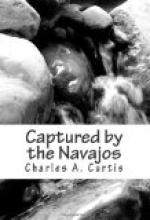Tent-pins were driven in deeper, guys tightened, cavalry horses driven up, hobbled, and secured to picket ropes, loose articles thrown into wagons, and every precaution taken to be in readiness for the storm.
We had not long to wait before the rain came down in torrents. In an incredibly short time the water was flowing swiftly down the slope to the river. It gathered against our tent, and finding the frail structure must go, we seized everything portable, dashed into the furious downpour, and climbed to the tops of surrounding bowlders.
Through the sheets of rain we could dimly see the cavalry horses standing knee-deep in water, men looking out of the covered wagons, into which they had crawled for shelter, or standing, like ourselves, on the bowlders, their bodies covered with ponchos and gum blankets. Wall-tents, the sides of which had been looped up when pitched, stood with the flood flowing through them; cranes, upon which hung lines of kettles in preparation for dinner, standing alone, their fires and firewood swept away. The whole country as far as we could see was one broad sheet of rushing water, and the river, which was little more than a rill when we crossed it a few hours before, now rolled and boomed, a torrent several fathoms deep and dirtier than ever.
The storm continued little over half an hour, and with the return of sunlight the surface water rapidly disappeared. Demoralized tents were then set up, baggage and bedding examined, and the wet articles exposed to the sun; and before night, except for the booming of the river, little remained to remind us that we had been through a storm.
Just before retreat, Frank, Henry, and I stood on the bank of the river watching the trunks and branches of trees rush past, and the occasional plunge of a mass of earth undermined by the current.
“Well,” said Frank, after silently contemplating the scene a few moments, “what you told us about crossing a stream before camping upon it has proved true, sir, and very quickly, too.”
“Yes; I think even the paymaster and surgeon must be congratulating themselves they are on this side of that flood,” I replied.
Next morning we resumed our march at the usual hour, and passed over 23.28 miles to a deserted Mexican town and Indian pueblo.
On the following day we crossed a chain of hills into the valley of the Rio Gallo. As we debouched from a deep ravine we caught sight of the pueblo of Laguna, illuminated by the sun, just rising, behind us. The town stands upon a rocky eminence overlooking the river, which waters, by irrigation, its large and well-cultivated valley.
When within four miles of it I proposed to the boys that we should hasten forward in advance of the wagons and visit the town. We galloped on, and were hospitably received by the Indian governor, who did the honors of the community in person. He showed us the interior of the terraced buildings, and conducted us through the subterranean estufa where, for centuries before the invention of the friction-match, the Indians kept their sacred fire—fire made sacred through the difficulty of obtaining it or rekindling it when once extinguished—and so watched day and night by sleepless sentinels.




